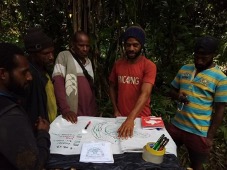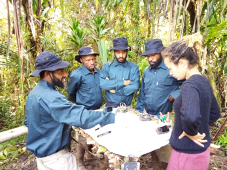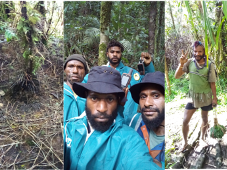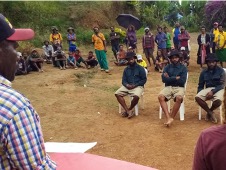On the 31st of August 2021, in the remote village of Kwiop, located in the Highlands of Papua New Guinea, 8 clans from the Manga Indigenous Peoples made history when their community-based organization, the Kuakam Landowners Foundation (KLF), signed the Mt Goplom Conservation Deed. In the local Narak language Kuakam means ‘cloud and rain’ and refers to the magnificent cloud-forest which covers Mt Goplom, a block of intact forest along the Bismarck Range. Though all land in the highlands is recognized by the government as community property, the Conservation Deed legally formalizes the KLF’s authority to manage their lands, and obligates the state to protect these rights. As part of the deed, the KLF allocated 4,200 hectares of intact forest as a conservation area. The US Ambassador Erin McKee and Governor William Tongamp, and Member of Parliament Wake Goi witnessed the signing.
The Deed formalized the geographic extent of the community’s traditional territory, details access and resource use rights and restrictions for different areas, and established a management committee authorized to ensure that community members fully understand and respect the new land and resource use rules. This means the committee must have the capacity to monitor and enforce these community by-laws, and tackle illegal activities by non-rights holders. The committee is also responsible for maintaining the road network within community territory.
With support from the Sustainable Wildlife Management (SWM) Programme funded by the European Union and the Lukautim Graun Programme, funded by USAID, and in expectation that the Conservation Deed would be signed before the end of 2021, the Wildlife Conservation Society coordinated with the KLF to begin the process of selecting and training community rangers. All candidates are hunters because their traditional knowledge of the forest, its trails, wildlife distribution, and human use patterns will be invaluable for monitoring and enforcing access and use rules. The KLF also felt that as the new resource use regulations would likely restrict their hunting, assuming the role of ranger might help compensate for the loss of access.
After all 15 candidates participated in 13 days of basic training, WCS and KLF selected the 5 individuals with the best tracking skills, traditional knowledge, motivation, team spirit, capacity to learn, discipline and attitude. These men formed the first team of community rangers and are called the WASMAN (watchman in Tok Pisin).
Five months later, in late November 2021, the WASMAN participated in an advanced training course carried out in the forest of the Mount Goplom Conservation Area. The 8 day training was conducted by WCS staff and was divided into 4 demanding training phases, through which each member of the team developed his technical capacity to record wildlife and human signs observed in the forest on paper and on Smartphone using the SMART app, mark points and tracks on GPS, navigate using GPS and compass, but also plan and execute a field mission, and provide a structured report to the community conservation management committee. To complete the training, the instructors also strengthened their understanding on conservation, surveillance and monitoring strategies.
After the training, the instructors and the trainees returned to Kwiop and reported back to the KLF. Community leaders, and members were allowed to ask questions. The next day, a mini-graduation ceremony was organised, during which KLF executives made a speech to the community on how the training is helping the community to strengthen their conservation and sustainable development vision, and the WCS instructors provided a summary on the outcomes of the programme.
 |
 |
| Introduction to mapping and conservation strategies. © WCS PNG |
Planning missions, setting objectives and preparing equipment. © WCS PNG |
 |
 |
| Situational training: the team was assigned various objectives involving wildlife monitoring, navigation location of targets (such as the bower of a MacGregor’s bowerbird (left), meeting point and geolocalized picture of the team (middle)) and evidence collection recording observations using SMART (human presence; right). The team reported results, challenges and provided recommendations back to the instructors. © WCS PNG |
CBO director George Okol and community leaders organised an award ceremony for the successful ‘wasmen’. © WCS PNG |
The rangers all felt that the advanced training had provided to them the skills and knowledge they need to effectively conduct field missions on behalf of KLF with standard, report back to the conservation management committee and community members on the conservation status of community lands and whether any evidence of illegal activities was detected, and inform decisions on how to best protect the Mt Golplom Conservation Area.
The next step will be to advise and assist the community conservation management committee to plan missions and to mentor the WASMAN team in the field so that they can continue to execute and apply what they have learnt. By doing so, KLF, WCS and their donors are setting the first model of community rangers in the Highlands of Papua New Guinea, which would open opportunities for upscaling in Kwiop but also replication in other communities WCS are engaged with to support conservation efforts. This will help each community achieve its conservation goals and ensure that community forest lands continue to provide the resources essential to their wellbeing and cultural identity.
The WASMAN initiative was made possible thanks to the support from the Sustainable Wildlife Management (SWM) Programme funded by the European Union and the Lukautim Graun Programme, funded by the USAID, in partnership with Cardno International Development.
_____________________________________________
The SWM Programme is developing innovative solutions based on field projects in fifteen countries of Africa, the Caribbean and the Pacific to improve the conservation and sustainable use of wildlife in forest, savannah and wetland environments. This seven-year (2018-2024) initiative is funded by the European Union with co-funding from the French Facility for Global Environment and the French Development Agency (AFD). It is implemented by a unique consortium of four organizations with expertise in wildlife conservation and food security: the Food and Agriculture Organization of the United Nations (FAO), the French Agricultural Research Centre for International Development (CIRAD), the Center for International Forestry Research (CIFOR) and the Wildlife Conservation Society (WCS).